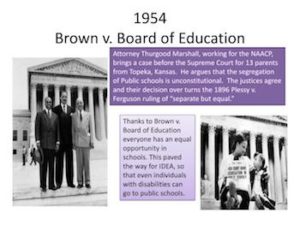
Brown v. Board of Education of Topeka was ruled on this date in 1954. This was a landmark court case in which the United States Supreme Court unanimously declared that it was unconstitutional to create separate schools for children based on race.
The Brown ruling ranks as one of the most important Supreme Court decisions of the 20th century. At the time of the decision, 17 southern states and the District of Columbia required that all public schools be racially segregated. A few northern and western states, including Kansas, left the issue of segregation up to individual school districts. While most schools in Kansas were integrated in 1954, those in Topeka were not.
Brown v. Board of Education developed from several court cases involving school segregation. One of these cases, based in Clarendon County, South Carolina, illustrated the unfairness of segregation. In the 1949-1950 school year, the average annual expenditure for white students in Clarendon County totaled $179, but for Blacks, it was only $43. The county's 6,531 Black students attended school in 61 buildings valued at $194,575.
Many of the Black schools lacked indoor plumbing or heating. The 2,375 White students in the county attended school in 12 buildings worth $673,850, which had far superior facilities. On average, teachers in the Black schools received salaries that were one-third less than teachers in the white schools.
In addition, the county provided free school buses for Whites but failed to provide them for Blacks. These circumstances led Blacks in Clarendon County to sue to create equal schools. In Briggs v. Elliott (1950), the United States district court in South Carolina ordered equal funding of Black schools but refused to mandate racial integration. The Supreme Court heard arguments in the Brown case in 1952, but the justices did not decide that year. Political divisions on the court ran deep, and the weak leadership of Chief Justice Frederick Moore Vinson made a decisive ruling unlikely. The court scheduled a re-argument in the case for 1953, but Vinson died before the arguments began.
His replacement, former California governor Earl Warren, was a skilled politician who brought renewed authority to the court. Moreover, Warren believed that segregation was fundamentally wrong. He successfully persuaded all the other eight justices to support a single opinion to end segregation. Warren himself wrote the statement of the court's decision, a document known as the court's opinion. Warren's opinion explained the context of the law regarding the case and detailed why the court reached its judgment. It was his first major judicial opinion since joining the court that year.
In April 1955, the court heard 13 hours of arguments over four days on how to end segregation in public schools. Ultimately, in what is popularly known as Brown II (1955), the Supreme Court turned the implementation of desegregation over to the federal district courts in the South. The district courts were ordered to desegregate schools with "all deliberate speed," an ambiguous phrase that allowed many southern judges to avoid desegregation for years.
In the original case, Linda Brown did not attend an integrated school until 1955, when she reached junior high school. None of the children of the 20 plaintiffs in the Clarendon County case ever attended integrated schools. Nevertheless, Brown helped launch the modern civil rights movement in education and led to other court decisions that struck down all forms of legalized racial discrimination.
Historic U.S. Cases 1690-1993:
An Encyclopedia New York
Copyright 1992 Garland Publishing, New York
ISBN 0-8240-4430-4